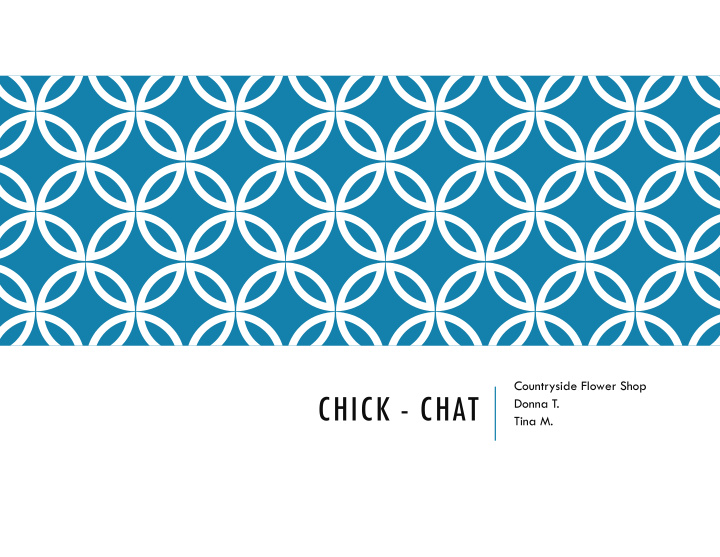



Countryside Flower Shop CHICK - CHAT Donna T. Tina M.
OVERVIEW Coop – safe housing for protection with roosting area for sleeping. 2-3 square feet per chicken Nest box – box in the coop for laying eggs. 12 x 12 inch box Roost – anything that is off the coop floor they can sleep on 12-18 inches per bird Run – a fenced in area usually attached or close to the coop. 8-10 square feet per chicken Free range/Pasture – access to outdoors and grass = 108 square foot per bird Cage free – lots of birds in a cage, no access to outdoors
HENS AND ROOSTERS Hen is a female chicken. A Pullet is a young female. Rooster is a male chicken. A Cockerel is a young male. Straight Run – chicks that are not sexed when you buy them. Flock – group of chickens Hens do not need roosters to lay eggs. Why have a rooster? Fertilize eggs for hatching – yeah more chicks! Protection – they will protect their girls Alarm clock – not really, they crow all day long!
COOPED FLOCK WITH SECURED RUN(S) - BENEFITS Coops are typically situated close to house, increasing flock security and easier maintenance (access to water & electricity). Family interaction while watering, feeding & collecting eggs teaches children valuable life lessons of responsibility & compassion for animals. With a small flock you will observe individual personalities & know which hen to thank for her eggs. Easier to detect health issues & behavior problems among flock members.
COOPED UP, SECURED RUNS - DRAWBACKS Chickens naturally prefer free range lifestyle & can be healthier. Coop and Run sizes limit the number of chickens (Coop = 4 sq ft per bird, Run = 10 sq ft per bird) Boredom must be prevented. Winter months cause more stress issues.
SO HOW DOES THIS WORK ON DAILY BASIS? Fresh water, fresh water, fresh water - every day, throughout the day!!! Fresh feed daily. Keep feeders & waterers clean. Biosecurity measures in place. Coops & runs cleaned daily for your family's health & the chicken's. Dropping boards scraped, scooped. Runs raked or scooped. Poop composted for future use. Refrain from broadcasting scratch & treats if possible. Put in trays, bowls. Lessens likelihood of parasite & bacterial infections. Above all else, enjoy & love thy flock! They will reward you with endless happiness & entertainment as well as nutritious delicious eggs.
FREE RANGE - BENEFITS Better Eggs – More vitamin A, D & E, Omega-3, less cholesterol and saturated fats Less work – Coop and Run do not require as much cleaning Bug Control – They eat grubs, Japanese beetles, ticks and other pests Lawn fertilizer – They poop lots! Stress reducer – Elbow space! More birds – If you have plenty of “sleeping” space, you wont need a big run Once you have a few chicks, they are addictive!
FREE RANGE - DRAWBACKS Dust Bathing – create circular dirt hollows anywhere they are allowed to roam Diet – eat almost everything that grows in your gardens and flowerbeds They poop – Everywhere they go! On your porch, sidewalk, and even while they sleep Can fly – over fences and into neighbors! Predators – Hawks, fox, coon, dog Egg laying – some force you to have an Easter egg hunt every day
HOW DOES FREE RANGE WORK Early morning open the coop door and let them out. Every night after they go to bed, lock the coop door! Yes, they put themselves to bed at dusk! (You can get powered coop door openers!) During the day. Access to feed, water, shade, nest boxes Area to run/hide for protection – bushes, covered area, etc. Cross your fingers and hope all return that night.
Recommend
More recommend